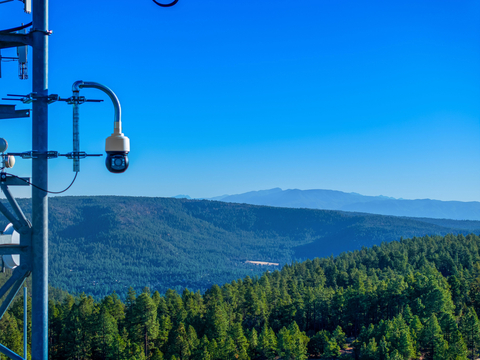Extra Eyes: APS, Firefighters Team Up With New AI Smoke-Detection Cameras
Technology aids in early wildfire detection and strengthens emergency response

Arizona Public Service artificial intelligence (AI) smoke-detection camera installed in northern
“The new AI cameras act as powerful extra sets of eyes. When minutes matter, early fire detection provides real-time information so firefighters can respond faster and we can make critical operational decisions about our energy grid to help keep communities safe,” said Scott Bordenkircher, APS Forestry and Fire Mitigation Director. “Our wildfire mitigation efforts over the past 10 years, strengthened by partnerships with federal land managers, the Arizona Department of Forestry and Fire Management and local fire departments, is key to delivering safe, reliable energy to customers.”
“The Arizona Department of Forestry and Fire Management knows the capabilities of the AI cameras and the critical asset they can be for the state when it comes to DFFM’s wildfire response. We will have the ability to tap into the cameras and those feeds will help increase our situational awareness as well as provide our dispatching center with timely information to relay to our boots on the ground,” said Tom Torres, Arizona Department of Forestry and Fire Management Director. “We appreciate the collaboration with APS to enhance our fire suppression response efforts so DFFM can better serve and protect our residents and communities.”
The new technology from Pano AI is helping mitigate wildfire risk through a variety of features, including:
-
More than 30 APS AI cameras mounted in elevated locations across
Flagstaff ,Payson ,Prescott ,Sedona , northPhoenix and southeasternArizona by this summer. - Smart AI that evaluates and detects fire smoke optimally within a 10-mile range and studies the way smoke looks to prevent mistaking other images like fog or dust as signs of wildfire.
- Connected satellite data that produces information on the size and location of the fire and 24/7 live stream using ultra-high-definition cameras with 360-degree views that can zoom in on a specific location.
“Arizona faces a growing threat from wildfires, and early detection is critical to protecting communities and infrastructure,” said Arvind Satyam, Pano AI Co-founder and Chief Commercial Officer. “By partnering with APS, we’re bringing cutting-edge technology and real-time intelligence to the frontlines of wildfire response. These AI-powered cameras spot smoke from miles away and provide actionable insights that help the utility and emergency responders move quickly and decisively.”
Recent examples of AZ wildfire detection through the lens of AI
December 2024:
- The Horton Fire, caused by human activity, ignited in the Tonto National Forest during a time of year when wildfire risk is typically low.
-
An AI camera in
Payson notified APS fire mitigation specialists of the smoke. (WATCH VIDEO). - APS fire mitigation specialists worked with first responders and because of weather conditions and APS’s previous removal of overgrown and unwanted brush, firefighters were able to use power line corridors as fire breaks to help keep flames from spreading.
- Firefighters used the cameras to help monitor the fire’s growth overnight.
February 2025:
- An AI camera in the Prescott National Forest detected smoke from the Brady Fire when it was less than one acre in size. (WATCH VIDEO).
-
Installed on a communication tower, in partnership with the
U.S. Forest Service, the camera system immediately notified APS and the forest’s dispatch center. - Firefighters’ swift and tactical response helped contain the fire’s spread and, due to the fire’s distance from power lines and the camera’s early detection of smoke, the fire did not impact APS equipment or service to customers.
What else does APS do to help reduce wildfire risk?
- APS takes an in depth, multi-layered approach that spans across many teams from fire mitigation specialists with experience working as wildland firefighters to tree experts, meteorologists, lineworkers, engineers, data analysts and drone pilots to keep power flowing safely and reliably through more than 38,000 miles of power lines.
- The APS Wildfire Mitigation program includes regular power line inspections, preventative upgrades, clearing hazardous brush and vegetation from power lines and wildfire monitoring technology, like weather stations, fire modeling software and high-definition cameras, utilized to help prevent, reduce and respond to wildfire risk.
For more information on APS’s wildfire mitigation efforts, visit aps.com/wildfiresafety. To learn more about the wildfire camera technology, visit pano.ai.
APS serves about 1.4 million homes and businesses in 11 of Arizona’s 15 counties, and is a leader in delivering affordable, reliable, and clean energy in the Southwest. The company is committed to serving customers with
View source version on businesswire.com: https://www.businesswire.com/news/home/20250325710585/en/
Media Contacts:
APS: Yessica del Rincon, yessica.delrincon@aps.com, 480-209-8513
Arizona Dept. of Forestry and Fire Management: Tiffany Davila, tdavila@dffm.az.gov, 602-540-1036
Pano AI: Jocelyn Johnson, jocelyn.johnson@pano.ai, 917-406-5886
Source: Arizona Public Service









